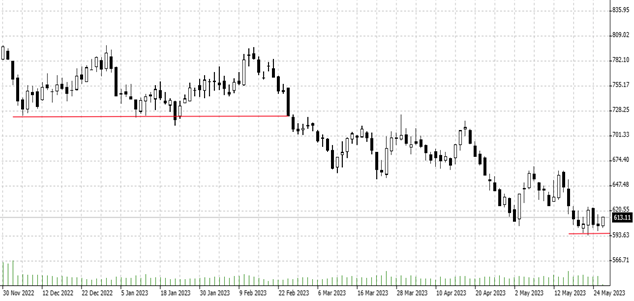

26.05.2023 – The panic has subsided, normality has returned. In other words, the market is ruling again, not the military. Since the high immediately after the Ukraine invasion, the wheat price has more than halved. The question is whether the downward trend will continue.
The blog “Invezz” just judged that there is no end in sight for the bear market in the short term. Thus, the wheat price – here the daily chart – first tore the support of 720 dollars. After that, the support at 596 had fallen. We have marked both levels with red lines. The verdict of “Invezz”: “Therefore, there is a possibility that the price will continue falling as sellers target the key support at $500.”
Whereby we briefly object at this point: The zone just below $600 seems to us to be still quite contested at the moment. We don’t see a final collapse of support here yet. Just look at how long it took until the 720 was finally broken through. Short bounces to the upside would not be a surprise – which should please bullish traders.

Source: Bernstein Bank GmbH
Be that as it may, the good news for the bears recently outweighed the bad news. About two weeks ago, the U.S. Department of Agriculture presented its first outlook for the 2023/24 harvest. The bottom line: a slight increase in production with demand picking up and inventories expected to fall slightly.
USDA figures
However, the USDA also slightly capped projections for 2022/23, with output from Ukraine in particular expected to fall, and the same for North Africa. At the same time, however, according to the World Agriculture Supply and Demand Estimates (Wasde), the buffer in the “old crop” increased by 1.23 million tons to 266.28 million tons compared to the previous outlook. Furthermore, the agency put the amount of the “new crop” at 264.3 millon tons – which was 7 million more than analysts had predicted to the blog “Fastmarkets Agriculture”.
Agreement extended
In addition, Russia and Ukraine agreed last week, with Turkish mediation, to extend the export agreement by two months. Both countries are major players in the grain market. Together, they account for nearly one-third of wheat exports, as reported by “Gro Intelligence,” which is a data service in the agricultural sector. In addition, Russia’s harvest isn’t due until July, so there’s still a lot of wheat that can hit the market. Bullish factors quickly evaporated recently, such as rumors that Russia was disrupting Ukrainian exports across the Black Sea.
At least “Invezz” saw signs of hope for the bulls – but only in the long term: “Still, in the long term, there is a likelihood that wheat prices will bounce back”. Thus, Ukraine’s output is likely to remain constrained for a long time. According to USDA, Ukraine will harvest about 16.5 million tons and export 10 million tons in the 2023/24 season. The comparative figures for the season before: 20.9 and 15 million tons. In addition, the harvest in Russia is likely to be 11 percent lower, he said. Furthermore, Australia will probably export a third less than normal due to the El Nino weather phenomenon. And then there is the fly in the ointment: Argentina will increase exports by 45 percent.
Our conclusion: We are curious to see whether many farmers will switch to other varieties in view of the predominantly bearish outlook. Then the bulls are likely to call the shots again. Only when? Whether long or short: Bernstein Bank wishes successful trades and investments!
______________________________________________________________________________________________________________________
The content of this publication is for general information purposes only. In this context, it is neither an individual investment recommendation or advice nor an offer to purchase or sell securities or other financial products. The content in question and all the information contained therein do not in any way replace individual investor- or investment-oriented advice. No reliable forecast or indication for the future is possible with respect to any presentation or information on the present or past performance of the relevant underlying assets. All information and data presented in this publication are based on reliable sources. However, Bernstein Bank does not guarantee that the information and data contained in this publication is up-to-date, correct and complete. Securities traded on the financial markets are subject to price fluctuations. A contract for difference (CFD) is also a financial instrument with leverage effect. Against this backdrop, CFD trading involves a high risk up to the point of total loss and may not be suitable for all investors. Therefore, make sure that you have fully understood all the correlating risks. If necessary, ask for independent advice. CFDs are complex instruments and are associated with the high risk of losing money quickly because of the leverage effect. 68% of retail investor accounts lose money trading CFD with this provider. You should consider whether you understand how CFD work and whether you can afford to take the high risk of losing your money.7
